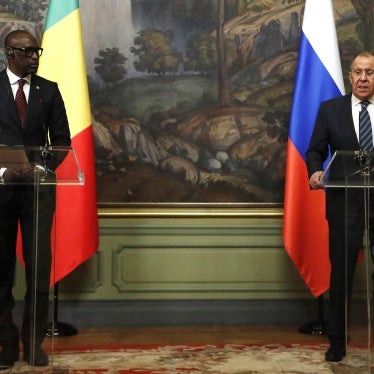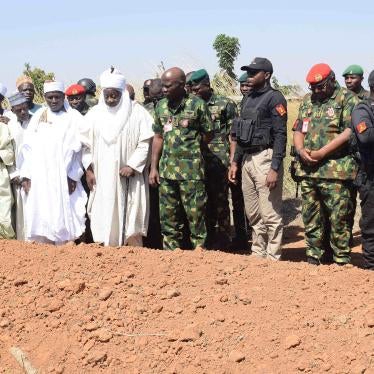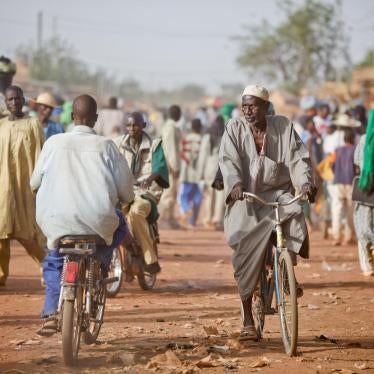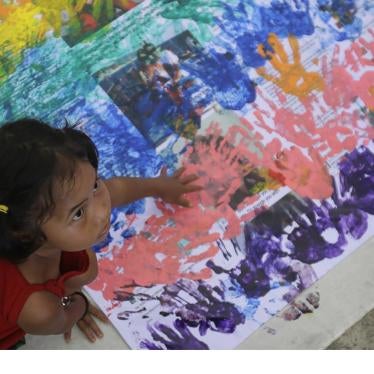(Nairobi) – There is strong evidence that Kenya’s Anti-Terrorism Police Unit (ATPU) has carried out a series of extrajudicial killings and enforced disappearances. Human Rights Watch also found evidence of arbitrary arrests and mistreatment of terrorism suspects in detention.
Kenyan authorities should urgently investigate alleged killings, disappearances, and other abuses by the unit and hold those responsible to account. International donors should suspend support to the unit and other security forces responsible for human rights violations.
“Kenyan counterterrorism forces appear to be killing and disappearing people right under the noses of top government officials, major embassies, and the United Nations,” said Leslie Lefkow, deputy Africa director. “This horrendous conduct does not protect Kenyans from terrorism – it simply undermines the rule of law.”
In research conducted in Kenya between November 2013 and June 2014, Human Rights Watch documented at least 10 cases of killings, 10 cases of enforced disappearances, and 11 cases of mistreatment or harassment of terrorism suspects in which there is strong evidence of the counterterrorism unit’s involvement, mainly in Nairobi since 2011.
Based on 22 interviews with family members, victims, witnesses, journalists, lawyers, imams, police officers, and terrorism suspects in Nairobi’s Majengo neighborhood, researchers found that suspects were shot dead in public places, abducted from vehicles and courtrooms, beaten badly during arrest, detained in isolated blocks, and denied contact with their families or access to lawyers. In some cases, members of the anti-riot forces known as the General Service Unit (GSU), military intelligence, and National Intelligence Service (NIS) were also implicated in abuses by the counterterrorism unit.
The ATPU was created within the Criminal Investigations Department (CID) in 2003 in response to the attacks on the US embassy in Nairobi in 1998 and on an Israeli-owned Mombasa hotel in 2002. Terrorist attacks have increased in Kenya in recent years, particularly after Kenya sent its military into neighboring Somalia in October 2011. There were at least 70 grenade and gun attacks in Nairobi, Mombasa, and Garissa between 2011 and 2014, with at least 30 attacks in 2012 alone, according to the US embassy. In September 2013, gunmen believed to be affiliated with the Somalia-based militant Islamist group Al-Shabaab attacked the affluent Westgate Mall in Nairobi, killing 67 people and injuring hundreds.
The counterterrorism unit has not formally acknowledged responsibility for the alleged killings, although in December 2013, an anonymous member of the unit told the BBC: “The justice system in Kenya is not favorable to the work of the police. So we opt to eliminate them [suspects]. We identify you, we gun you down in front of your family, and we begin with the leaders.” Human Rights Watch’s request to discuss the findings with the ATPU commandant, Boniface Mwaniki, was declined.
The police spokesman has stated publicly that in at least three separate cases the suspects died in “fire exchange” with the unit’s officers. But Human Rights Watch findings in each of the three cases contradict that assertion. In the case of Hassan Omondi Owiti and Shekha Wanjiru, for example, witnesses said that officers from the counterterrorism unit and the General Service Unit had surrounded their apartment block in Nairobi’s Githurai Kimbo estate in the evening of May 18, 2013, then stormed their apartment and shot them dead without armed resistance.
In another example, Lenox David Swalleh and an unidentified person were shot on November 13, 2013, as they left a mosque after morning prayers in Nairobi’s Eastleigh neighborhood. While police claimed that other people were killed while preparing to rob a bank, witnesses and family said the two were unarmed and were shot without warning. The men had been accused of involvement in a November 2012 grenade attack on the Hidaya mosque in Eastleigh that killed 6 and injured 15, but the two were being held at Industrial Area Remand Prison at the time of the attack and were only released on April 16, 2013.
Kenyan authorities have not effectively investigated these cases or any anti-terrorism unit officers for alleged abuses, including the targeted killings of high-profile clerics such as Sheikh Aboud Rogo in August 2012; Sheikh Ibrahim Omar, who replaced Rogo at Masjid Musa, and who was gunned down near the same place in October 2013; and Sheikh Abubakar Shariff, aka Makaburi, who was killed on April 1, 2014.
The Kenyan government had accused the clerics of recruiting youths from Masjid Musa mosque for Al-Shabaab, and was prosecuting Rogo and Makaburi on those charges. The government established a task force to investigate Rogo’s killing. The task force in August 2013 reported that police had mishandled the crime scene and recommended a public inquest. The public prosecutions director promised to set up an inquest in August 2013 but has not done so.
The counterterrorism unit receives significant support and training from the United States and the United Kingdom. A 2013 report by the Congressional Research Service said that the United States had provided US$9 million in Anti-Terrorism Assistance to Kenya in 2012 alone, part of which went to training for the ATPU. The United States has not scaled down its assistance to the unit or opened an investigation into its abuses, despite credible allegations of abuse, including in the US annual human rights report on Kenya.
“The ATPU has been conducting abusive operations for years, sometimes very openly, yet the Kenyan authorities have done nothing to investigate, much less stop these crimes,” Lefkow said. “Donors need to carry out their own investigations of these abuses and suspend their assistance to abusive forces, or risk being complicit in Kenya’s culture of impunity.”
Background
Human Rights Watch research adds to the growing litany of allegations against the counterterrorism unit. In November 2013, the Open Society Justice Initiative and a Mombasa-based nongovernmental organization, Muslims for Human Rights (MUHURI), published a report documenting extrajudicial killings and disappearances in Mombasa connected to the unit since 2007.
In 2007 and 2008, Human Rights Watch and the Muslim Human Rights Forum separately documented the involvement of the unit and other Kenyan security forces in the arbitrary detention and unlawful rendition of at least 85 people, including 19 women and 15 children, from Kenya to Somalia. The unit has also been linked to the unlawful rendition of alleged suspects from Kenya to Kampala, Uganda, following the July 2010 World Cup bombings.
A US law, commonly known as the “Leahy Law,” prohibits support to a unit of foreign security forces if the Secretary of State has “credible information” that the unit has committed a “gross violation of human rights.” Once aid is suspended, it can only resume if the recipient government “is taking effective steps to bring the responsible members of the security forces unit to justice.”
US officials in Nairobi have told human rights organizations they needed more evidence on individual officers to withhold support to the counterterrorism unit. While identifying the names of individual officers can be challenging, particularly as the officers allegedly involved in killings and other abuse often wear civilian clothes and conduct operations with other Kenyan security forces, the evidence is overwhelming that the unit’s officers are involved in serious abuses.
Killings with Suspected ATPU Involvement
Human Rights Watch found evidence of at least 10 cases of extrajudicial killings of terrorism suspects, some of whom were last seen in ATPU custody or had been threatened by the unit’s officers after courts had released them. Several suspects were facing terrorism-related charges and required to report to the unit either weekly or monthly and had told family and friends they had received death threats from ATPU officers they recognized. In other cases, the threats were issued in the presence of associates that Human Rights Watch interviewed.
In at least three of the killings, the unit claimed that the suspects were killed in a firefight. Human Rights Watch did not find evidence of a shootout, as witness descriptions painted to a short-lived, targeted killing by security officers and the scene suggested the shooting was unidirectional without any damage to the surrounding buildings as ATPU had suggested. In other cases, the ATPU did not accept responsibility for the killings, but its officers were either seen with the suspects before they were killed or took the bodies to the mortuary without notifying the families.
Under Kenyan and international law, police may use lethal force only when necessary for self-defense or to save a life. Section 4 of the Sixth Schedule of the National Police Service Act of 2011 requires police officers who use lethal fire to report to their immediate superior explaining the circumstances that necessitated the use of force. Section 5 of the same act requires officials to report any use of force that leads to death or serious injury to the Independent Police Oversight Authority for investigation. Police authorities have not complied with these requirements in these cases of extrajudicial killings.
The United Nations Basic Principles on the Use of Force and Firearms by Law Enforcement Officials require law enforcement officials to use nonviolent means whenever possible and to use lethal force only when strictly unavoidable to protect life. The principles also require governments to ensure that arbitrary or abusive use of force and firearms by law enforcement officials is punished as a criminal offense under their law.
Shabaan Namusenda Makotse, Mombasa, April 2013
On October 21, 2012, the ATPU published names and photographs in newspapers of four men they said were wanted terrorism suspects: Shabaan Namusenda Makotse, Hassan Omondi Owiti, Yassin Olunga (alias Ndung’u), and Ali Msadiki, the younger brother of Owiti’s wife. The statement also alleged that Makotse was connected to an October grenade attack in Likoni.
The same day, the police spokesman at the time, Eric Kiraithe, said at a news conference that Makotse and the three other men were wanted by police for planning other attacks in Mombasa.
Makotse was killed in April 2013. Two witnesses who were with him the day he was killed told Human Rights Watch that three gunmen shot Makotse as he ate fruit salad on a wooden bench in Mombasa’s Kisauni area. The witnesses said the gunmen were plain-clothes police officers whom they recognized to be members of the ATPU.
Makotse had told family and friends for several months that he was being tailed by people he recognized as ATPU officers.
Hassan Omondi Owiti and Shekha Wanjiru, Nairobi, May 18, 2013
On May 18, 2013, at least eight ATPU officers, together with others from the GSU and regular police from the Githurai police station, carried out a night raid on a block of residential buildings in Githurai Kimbo estate, Nairobi, killing Hassan Omondi Owiti and Shekha Wanjiru, a woman who was with him in the apartment.
In a statement to the media on May 19, the ATPU commandant, Boniface Mwaniki, said his officers had killed a man named Felix Nyangaga Otuko and his wife, a Somali national, after nearly six hours of gunfire and that the couple had hurled four grenades that injured six officers. However, one of Owiti’s relatives told Human Rights Watch that an ATPU officer called the victim’s family to the ATPU headquarters a day after the killing, where a senior officer informed them that they had killed Owiti rather than Otuko. The relatives found the bodies of Owiti and Wanjiru in the mortuary.
Three witnesses and a neighbor in the building said the security forces had surrounded the block of apartments, ordered the occupants out, and did not encounter any armed resistance or grenade attacks. Witnesses described “commandos” wearing red berets and full combat gear carrying sub-machine guns. Evidence suggests these forces were a sub-unit of the GSU that participated in the operation led by the ATPU.
“We saw several commandos wearing balaclavas in the middle of the night alight from vehicles dashing into the house,” a 34-year-old businessman who lived in a neighboring block told Human Rights Watch. “We heard continuous gunshots for about two minutes and then there was a lull in the shooting. We then heard that two terrorists had been killed.”
ATPU officers had been tracking Owiti and the three other men identified in the October 2012 statement for several months.
Khalif Mwangi, Nairobi, May 20, 2013
The mutilated body of Khalif Mwangi, 29, turned up in a sewage ditch in Nairobi West on May 20, 2013, two days after Owiti was killed. The counterterrorism unit had also been investigating Mwangi, a close friend of Owiti’s. Mwangi’s name and photo were published on a police website and by media in early 2012.
Mwangi had been missing since April 20, but family and friends were not aware of his death until an NTV broadcast showed clips of his mutilated body on May 20. A few days later, an ATPU officer informed Mwangi’s lawyer that the body was his client’s.
A relative who saw the body in the mortuary told Human Rights Watch that it bore fresh signs of torture, suggesting he had been killed just days before. “It was horrifying to view the body,” she said. “We think he was badly tortured before he was killed. His skin had been peeled off, eyes gouged out, ears burned with acid, finger nails and toes removed and the skull was broken.”
Family members said they saw ATPU officers taking fingerprints of Mwangi’s corpse at the mortuary and suspected ATPU officers were monitoring people who went to view the body. “We never picked [up] the body for burial out of fear,” said a family member.
Ibrahim Ramadhan Mwasi, Nairobi, June 17, 2013
Ibrahim Ramadhan Mwasi (alias Ruta), in his mid-20s, was shot dead on the evening of June 17, 2013, by a lone gunman. The identity of the gunman has not been established but witnesses believe ATPU officers were responsible.
Ruta was among six suspects in a grenade attack on the Machakos bus station in Nairobi on March 10, 2012, that killed 9 people and injured at least 60. The ATPU had arrested the six suspects two weeks after the attack and arraigned them in Nairobi’s Kibera court in late March 2012 on charges of engaging in organized crime and being members of Al-Shabaab, after which they were released on bond.
The others, all in their mid- to late-20s, were: Abdul Rahman Daud (Mjomba), Sylvester (Musa) Opiyo Osodo, Hussein Abbas Mwai Nderitu, Stephen Mwanzia Osaka (alias Dudah Brown), and Jeremiah Onyango Okumu (alias Dudah Black).
Three of the others disappeared. Only Nderitu and Daud are known to still be alive.
Many witnesses in Nairobi told Human Rights Watch that the ATPU had threatened to kill the six suspects. “ATPU officers started threatening the [suspects] that even if the courts freed them for lack of evidence, they would still find a way of dealing with them out there,” said one witness, a suspect also being investigated for terrorism and a close friend of Ruta.
A man in his late 20s who was with Ruta on the night he was shot recalled: “Ruta was leaving Riadha mosque in Majengo, Nairobi, after evening prayers when he decided to [use the] nearby public toilet. The lone gunman in a black leather jacket followed him there. We just heard gunshots inside the toilet. He was shot twice in the head and once in the chest. Nothing was stolen from him.”
Lenox David Swalleh and another person, Nairobi, November 2013
On November 13, 2013, the Nairobi county police commander, Benson Kibui, told Kenyan media that police had killed two of the most wanted terrorists that day but did not identify them. Human Rights Watch learned that one of the two men was 28-year-old Lenox David Swalleh.
Kibui told the media that the men were killed while on their way with two other men to rob a bank in the Eastleigh area of Nairobi. He said they were part of the terrorist group that had thrown a grenade at worshippers at Hidaya mosque in Eastleigh on December 7, 2012, killing 6 people and injuring 15, including the legislator for the area, Yusuf Hassan.
However, a family member contended that Swalleh was killed as he was returning home from early morning prayers. His body was taken away by police, and the family later identified it in the mortuary. Witnesses at the mosque confirmed that Swalleh had been in the mosque that morning.
Evidence also suggests that Swalleh was not involved in the grenade attack. Court records and interviews with other inmates indicate that Swalleh was in prison on charges of organized crime and membership in Al-Shabaab at the time of the Hidaya mosque attack.
Family members and inmates at Industrial Area Remand Prison said that ATPU officers who visited and interrogated the inmates had threatened to kill Swalleh if the court released him. He was released on April 16.
Ibrahim Tafa Tuwa and Hamisi Juma, Nairobi, January 8, 2014
On January 8, 2014, the ATPU claimed at a news conference that it had killed two other terrorist suspects in Nairobi, allegedly part of the same gang that attacked Hidaya mosque in December 2012. It did not name the two.
Witnesses said they saw ATPU officers at the scene of the killings, and a witness saw two ATPU officers take the bodies of Ibrahim Tafa Tuwa, in his mid-20s, and Hamisi Juma, also in his mid-20s, to Nairobi’s City Mortuary on that day. Both had been detained on terrorism charges with Swalleh.
Several witnesses, including former inmates who were detained with the two men, confirmed that the ATPU had visited them in prison several times and threatened to kill them if the court freed them.
“ATPU said they were in charge of running our block and could do anything with us if we did not do what they wanted,” a former inmate told Human Rights Watch. Tuwa’s relatives also said that ATPU officers had threatened to kill the suspects if they were released. The men were also released on April 16, 2013.
Sheikh Hassan Suleiman Mwayuyu, Mombasa, December 5, 2013
Sheikh Hassan Suleiman Mwayuyu, a tailor, was killed on a public minibus on December 5, 2013. Mwayuyu was returning home from the Mombasa law courts where he had attended a hearing for his sister, Rahma Hassan, who faces terrorism-related charges.
Kenyan security had described Mwayuyu as a terror suspect believed to be planning an attack. Two 2012 National Intelligence Service (NIS) reports accused Mwayuyu, along with others, of planning grenade attacks in Mombasa.
Witnesses to Mwayuyu’s death told Human Rights Watch that four gunmen blocked the minibus at around 6:15 p.m. at Tiwi junction, shot the tires, and ordered everyone inside to lie down. Another witness, a community mobilizer for a Mombasa based human rights organization, said one of the gunmen looked like an ATPU officer he had seen in court.
The ATPU had previously threatened Mwayuyu, including that same day. A relative who attended the court hearing told Human Rights Watch in a phone interview: “There were so many ATPU officers in the court. One of the officers walked over to my cousin [Mwayuyu] in court and said, ‘Today is your day and we are here to ensure you don’t continue with what you have been doing.’ It was a threat.”
A Mombasa-based Catholic cleric and human rights activist, Father Gabriel Dolan, wrote in the local Daily Nation on December 20, 2013:
On December 2, I received a text message from Mombasa police warning church leaders that a certain Sheikh Suleiman Mwayuyu was planning to burn select churches within Diani, Changamwe and Kisauni the following day. This particular warning was unusual on two counts: that a particular planner of the violence was named and that the same man was killed three days later.
Possible Enforced Disappearances
Human Rights Watch documented the enforced disappearances of at least 10 young men by ATPU officers from Nairobi between 2011 and 2013. The men faced terrorism-related charges in various Kenyan courts, were under investigation by the ATPU, or had been acquitted. All of them had told family members, friends, and associates whom Human Rights Watch interviewed that they received direct death threats from ATPU officers.
The International Convention for the Protection of All Persons from Enforced Disappearance, which Kenya has not signed, defines an enforced disappearance as “the arrest, detention, abduction or any other form of deprivation of liberty by agents of the state or by persons or groups of persons acting with the authorization, support or acquiescence of the state, followed by a refusal to acknowledge the deprivation of the liberty or by concealment of the fate or whereabouts of the disappeared person, which place such a person outside the protection of the law.”
Sylvester (Musa) Opiyo Osodo and Jacob (Yaqub) Musyoka, Nairobi, May 23, 2012
Sylvester (Musa) Opiyo Osodo and Jacob (Yaqub) Musyoka, both in their late 20s, were kidnapped by at least 10 armed men on May 23, 2012, at around 8 p.m. when their vehicle broke down outside Nakuru at the Molo-Mau Summit junction, along the Nakuru-Kisumu highway.
Witnesses and family members believe ATPU officers abducted them because the men had been threatened and were facing charges. Osodo was among the six accused in the Machakos bus station bombing case. Musyoka, who became a friend of Osodo’s in the Industrial Area Remand Prison in March 2012, was facing charges of engaging in organized crime.
The two men were travelling from Nairobi to Kisumu with two women and two school-age children wearing school uniforms. According to witnesses, the car broke down several times that day and the group decided to spend the night in the car in Molo after a mechanic was unable to repair it. That evening, the armed men witnesses believed to be plain-clothes officers forced the men into their car and drove away, leaving the women and children in the car. The men have not been seen since.
Friends and family members believe the abductors were ATPU officers because Osodo had recognized a senior ATPU officer following them in a white car when they stopped in Nakuru earlier that day to fix a tire.
“Osodo assured the group not to worry because he had informed the lawyer representing him in the case with five others in Nairobi about the trip and his lawyer had alerted the ATPU headquarters as per conditions set by ATPU,” the witness said.
During court proceedings, which continued even after suspects either disappeared or were killed, the ATPU claimed the two had fled to Somalia. However, according to the defense lawyer, the ATPU failed to present a report of their investigations to the court as would have been expected.
Jeremiah Onyango Okumu, Stephen Mwanzia Osaka, Salim Abubakar Hamisi, and Omar Shwaib, Nairobi, June 26, 2012
Jeremiah Onyango Okumu (alias Duda Black) and Stephen Mwanzia Osaka (alias Duda Brown), both in their mid-20s, were also among the six men facing terrorism-related charges for the March 2012 Machakos bus station bombing.
They vanished on the evening of June 26, 2012, along with two other young men, Salim Abubakar Hamisi and Omar Shwaib (alias Justo), a day before the two were due back from a shopping trip to Mombasa.
A relative said she last talked to Okumu at 4 p.m. on June 26, during which he said they had bought everything they wanted and would take a bus back to Nairobi on the morning of June 27. “After that, his phone started going unanswered,” she told Human Rights Watch. “The family they were putting up with in Mombasa’s Kisauni neighborhood reported that they had not returned home that evening.”
Human Rights Watch interviewed witnesses in Mombasa who saw the four men being kidnapped at around 5:30 p.m. by several armed men in civilian clothes near the Likoni ferry. Several of the witnesses said they recognized the armed men as ATPU officers.
Dudah Black and Dudah Brown had told family and associates several weeks before they disappeared that the ATPU was threatening them. The Likoni Ferry Police Post officers did not respond even though the men were abducted nearby and appeared unconcerned when relatives reported the disappearance. A duty officer at Likoni Ferry Police Post advised the family to look for their bodies in the mortuary, as they had been shot by police.
The families of the four men never found their bodies. On June 30, they gave statements about their missing relatives at Nyali Police Station, near Kisauni, where the four had been staying in Mombasa, but police did not respond.
During court proceedings in the Machakos bus station bombing case, the prosecutor told the court that Dudah Black and Dudah Brown had both fled Kenya to avoid prosecution and that the authorities had not pursued any further investigations.
Abdulaziz Muchiri and Ali Kipkoech Musa, Nairobi, May 6, 2013
Abdulaziz Muchiri, 24, and Ali Kipkoech Musa, 22, both of whom were being investigated by the ATPU over their possible links to Al-Shabaab, were arrested by ATPU officers using what appeared to be excessive violence, at Musa’s house in the Kariobangi South neighborhood at 5 p.m. on April 20, 2013. They were detained without charge and appeared in court twice, but then were taken to an undisclosed location and remain missing.
A man who witnessed the arrest told Human Rights Watch: “The officers arrived in six white Toyota vehicles, with each vehicle carrying up to five officers, and immediately ran to their flat on the ground floor. The young men did not resist the arrest but the officers just descended on them with force. They then dragged them on the ground to the waiting vehicle.”
The men’s families learned about their arrests after the two called from police custody three days later. Relatives of both men said that they were in poor condition, their bodies were swollen, and their clothes were stained with blood. Musa’s mouth, face, and back were bruised and he could not walk, relatives said.
The ATPU failed to take the men for medical treatment, the relatives said. In a hearing on April 22, 2013, the court extended their detention by 14 days at the ATPU’s request, in the absence of the accused and their lawyers, their lawyer and families said.
The two men were last seen in court on May 6, 2013. “An ATPU officer walked over to the judge and whispered in her ear,” recalled one relative who attended the hearing. “The judge then directed him to remove the accused from the courtroom…. We tried to follow them … but the officers ordered us to wait outside. They told us the charges had been dropped.”
The ATPU officers then drove off with the two men in a black land cruiser, family members said. In the court files, the police prosecutor indicated that the two men were responsible for training terrorists in Kenya and, on the day of their arrest, had attempted to kill officers. An ATPU affidavit stated that the two men were arrested with hand grenades and 20 rounds of ammunition. The file also shows that the ATPU dropped charges against the two.
The families have tried to file complaints but have been turned away at several police stations and have been sent from station to station. “No one wants to touch the case,” said a relative of Muchiri. Since they last appeared in court, the authorities have provided no information about their whereabouts. The ATPU has denied to the men’s lawyer that the men are in its custody.
Yassin Olunga and Ali Musadiki, last seen in Nairobi in April 2013
Two other young men who police said were under investigation for terrorism, Ali Musadiki, in his teens, and Yassin Olunga (alias Ndung’u), in his mid-20s, were last seen on April 2013 in Nairobi. The ATPU had published their photos, together with a photo of Owiti, Musadiki’s brother in-law, in Kenyan newspapers on October 21, 2012, describing them as terrorists planning attacks in Mombasa and Nairobi.
Their whereabouts are unknown, as is who is responsible, but family and friends suspect that ATPU officers killed or kidnapped them because the two men had several times told family members they had been followed by known ATPU officers from Mombasa. Family members reported the men’s disappearance to police in Nairobi but the families say they are unaware of any ongoing investigation.
Harassment, Threats, and Mistreatment in Detention
Human Rights Watch found that ATPU officers harassed, threatened, and beat suspects, and held them for long periods without judicial review or the chance to object to extension of their detention periods. Under Kenyan law, suspects must be brought before a court within 24 hours and have the right to be present when a court decides whether to extend their detention.
In the Muchiri and Musa cases, ATPU officers kicked and beat the suspects with gun butts, then dragged them to a waiting car. The officers detained the two suspects for 16 days without treating the injuries inflicted during the arrest and failed to notify their families about the arrests. The officers also did not present the suspects in court, as required by law, while seeking orders to extend their detention.
In four additional cases Human Rights Watch documented, ATPU officers beat suspects, did not bring them to court as required, and held them for long periods without charge.
The wives of two terrorism suspects were detained with their week-old babies on two separate occasions in Nairobi in March 2012. A 41-year-old grandmother said she was summoned to the ATPU headquarters in Nairobi after police killed her relative: “They accused me of … receiving dollars from terror groups. They said it was only a matter of days before they kill me the way they killed my [relative]. I know they will kill me, yet I have done nothing wrong.”
The ATPU also arrested and detained minors. In one example, a 17-year-old student at a Nairobi school told Human Rights Watch that he was arrested in April 2012 and detained for a year, first at Garissa police station and then in Shimo la Tewa prison:
I was interrogated by ATPU officers for days in the absence of an adult or a lawyer. I was then taken through a normal court process and not a juvenile court as required. An appeal court judge freed me after one year and criticized the lower court for failing to protect our rights and convicting us without evidence.








